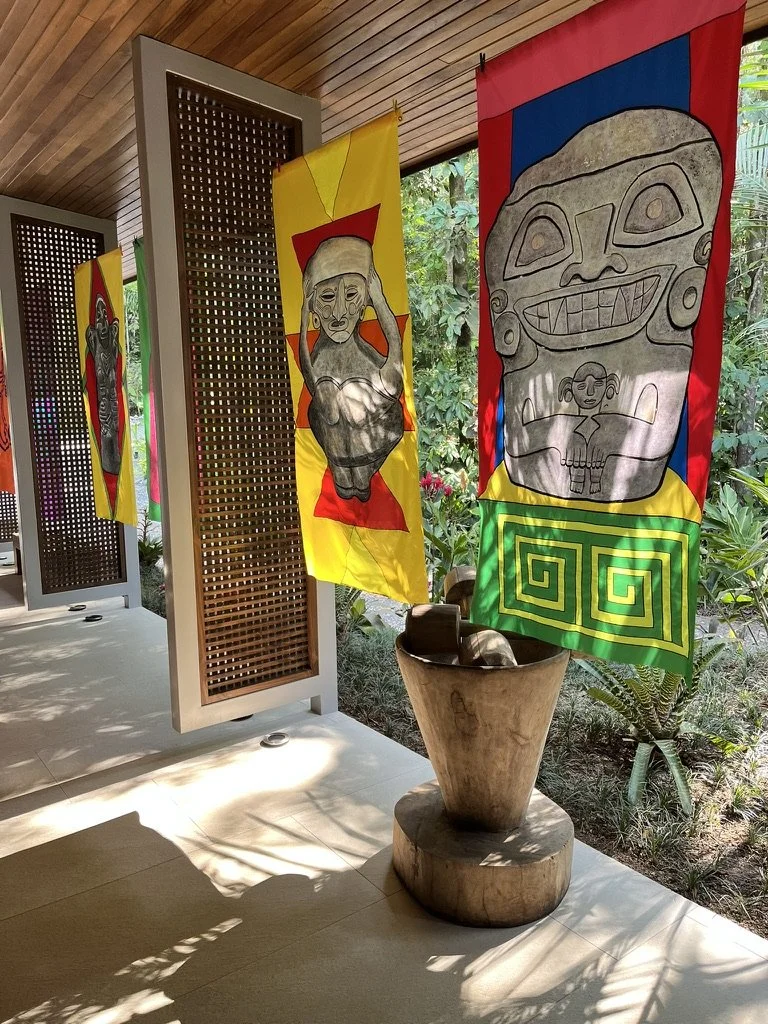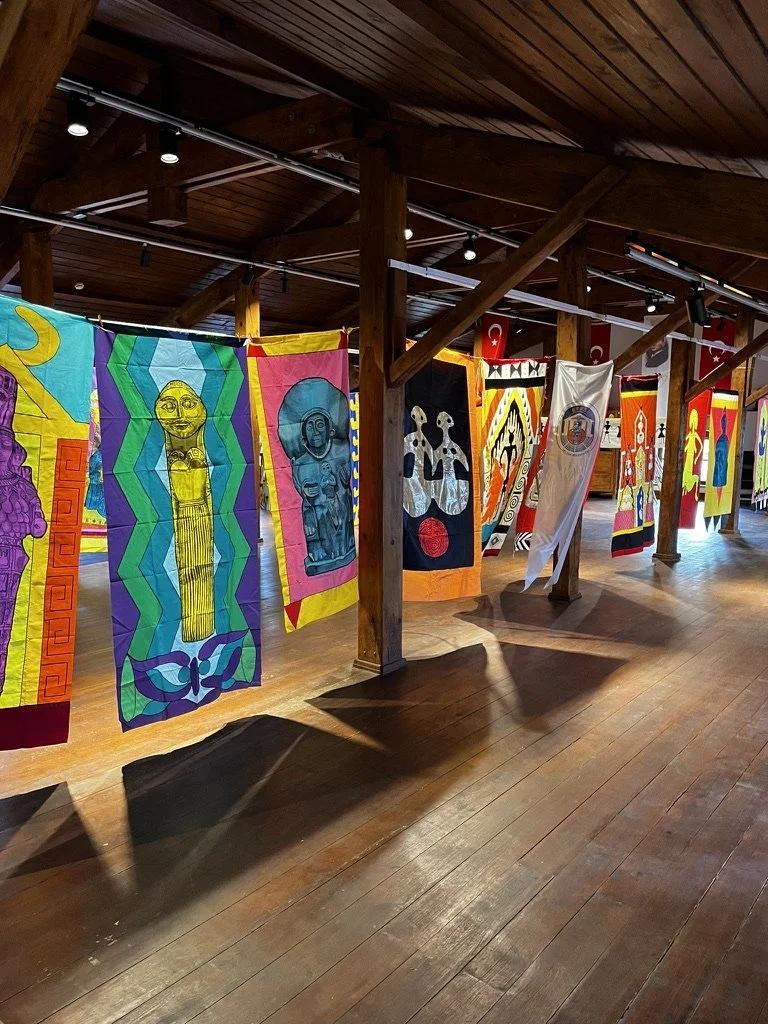goddess banners
Lydia Ruyle’s goddess banners are truly a rare body of work.
The goddess banners represent approximately 30 regions across the globe spanning millennia and bring to life multiple ancient and modern cultures where the sacred feminine is celebrated and revered.
The Goddess Icon Spirit Banners made their debut in 1995, at the Celsus Library in Ephesus, Turkey. Since then, the Goddess Banners, which began with eighteen and now number over 300, have traveled around the globe in over forty countries, at conferences, universities, sacred sites, museums, festivals, kindergartens, a golf course, a musical, a funeral, and a woman’s prison. They have hung at many sacred sites: Machu Picchu, Chartres, Kathmandu, Putuoshan, and Jeju Island.
For those that have had the privilege to be in the presence of the goddess banners know the impact they have on both the internal and physical space of the people and the area where they are hanging. These banners hold numinous energies and shift an ordinary space into a sacred one. The art embodies a rare power that transcends words and allows the spirit of the divine to be encountered, felt, and experienced in a very personal way. This was Lydia’s goal - to bring back the sacred feminine and their stories through an art form that fostered inclusivity, easy access, and profound inquiry into one’s own life journey and to reshape modern HIStory to include HERstory.
Meet “The Girls”
Below are 13 images from Lydia Ruyle’s portfolio of over 300 Goddess Banners. These were carefully curated as a first introduction to the collection and represent diverse cultures and different periods of Herstory throughout time.
All the descriptions below include the source of the image and its archeological reference along with a brief summary in Lydia’s own words of the essence of the image.
-

Anadolu Twins
Source: Gold pin, c.2400 BCE, Alacahuyuk, Anatolian Civilizations Museum, Ankara, Turkey
Anadolu Twins vibrate with the transformational energy of human relationships between parent-child, feminine- masculine, teacher-student, friend-foe, spirit-matter, idea-reality. Nothing in the universe exists in isolation. Everything in is in relationship. Connections create energy. Wise, fierce, matriarchal Medusa watches over relationships.
-

Angkor Wat Aspara
Source: Stone, Bas-relief, 12th Century, Angkor Wat, Cambodia
Angkor Wat Apsara Dancing Apsara from Angkor Wat in Cambodia is celebrating the life of the spirit. Apsaras are celestial dancers who are able to change shapes at will and move between the celestial and mundane realms. They also congregate near sites associated with death in order to capture souls. Apsara dances on a lotus flower in her niche at Angkor Wat, a magnificent Khmer Hindu temple, the home of nearly two thousand images of the feminine divine.
-

Crow Mother
Source: Katsina, Painted Wood, N.D. Hopi, Museum of Northern Arizona. Flagstaff, Arizona, USA
Crow Mother is the mother of all the katsinas who are spirits of the Hopi universe. The Hopi, which means peace, believe all beings in the universe carry energy. They are one of the oldest living pueblo cultures and reside on three mesas in northern Arizona. Crow Mother appears during the Powamu or Bean dance, which opens the ritual year. She offers corn to sustain life and switches for discipline and protection. She stands on a rock art labyrinth symbolizing the human journey of life. Black crows hang out around humans and love corn.
-

Lilith
Source: Terracotta plaque, c.1750-1800, Old Babylonian, The Burney Relief, British Museum
Lilith faces you with her lions and owls. She wears a crown with horned tiers and a necklace. Her wings show her relationship to the sky and heaven and she stands on her sacred earth mountain. Lions and birds are the oldest epiphanies of the goddess in paleolithic and neolithic art. A Hebrew midrash depicts Lilith as Adam’s first wife who made her own decisions. When she refused to obey Adam, she flew away.
-

Green Tara
Source: Woodcut, Tibet
Tara is the compassionate great mother of Buddhism and the Himalayan kingdoms of Bhutan, Nepal and Tibet. Green is her growing and flowering aspect. She may also be red, yellow, white or black. Tara sits on a flowering lotus under a blue moon surrounded by a golden aura. In Bhutan, Tara is called Tsering Ma and she rides a lion.
-

Hecate
Source: Engraved gem, Rome, Italy
Hecate is the triple Goddess and mistress of fate and the underworld. She sees the past, present and future. The virgin is white, the mother, red
and the crone is black. She is the guardian of the crossroads and holds swords of discernment and fires of transformation. She stands on her entwined twin serpents. -

Mami Wata
Source: Lithograph, 1926, painted by German (Hamburg) artist Schleisinger, displayed in shrines as a popular image of Mami Wata in Africa and in the Diaspora.
Mami Wata is connected
to the ancient African water spirit traditions regarded as female. In the last century, European traders brought a German lithograph image to Africa which influenced native images of Mami Wata. Her image figures prominently in the folk art of Africa adorning walls of bars, living rooms, album covers, and other items. Mami Wata is a popular subject as well in the art, fiction, poetry, music, and film of the Caribbean. -

Scottish Sheela Na-Gig
Source: Stone relief, Meigle, Perthshire, Scotland
Scottish Sheela-na-gig symbolizes the spiraling energies and myriad winding pathways of transformation through the feminine. She holds snakes, another transformational symbol, in her upraised arms. Her legs weave serpentine patterns which end in two mermaid’s tails. A pattern of interlacing Celtic knots and colors create the background.
-

Snake Goddess of Crete
Source: Clay sculpture, c.1600 BCE, Herakleion Museum, Crete
Snake Goddess of Crete holds snakes in her upraised arms, a gesture of power. An owl representing feminine wisdom rests on her crown. She is framed by a temple shrine and stands on an egg shaped omphalos, sacred opening. Horns of bulls top the banner. All are symbols of the goddess. Each of us gives birth to ourselves every day through the choices we make as we experience of life. Like the snake who miraculously sheds its skin, we are reborn and continue our journey.
-

Tsagaglalal
Source: Petroglyph, N.D., Columbia River, Horse Thief State Park, Washington, USA
Tsagaglalal is also known as “She Who Watches.” Carved in red sandstone on a cliff overlooking the Columbia River in Washington state, she is probably the most famous petroglyph in the Northwest. A legend describes Tsagaglalal as a woman chiefess watching over her people. Perhaps, she is related to Bear Mother Goddesses of northern Europe.
-

Venus of Willendorf
Source: Stone sculpture, c.30,000 BCE, shrine, Naturhistorische Museum, Vienna, Austria
Venus of Willendorf is over 30,000 years old and the most well known paleolithic Venus. She is well endowed, small and mighty. On her head is a seven circle labyrinth. Her rainbows of energy in the banner background ripple around the world. For the new millennium, the Naturhistorische Museum in Vienna created a special shrine room for their most visited Venus.
-

Virgen de Guadalupe
Source: Painting on cloth, c.1534, Guadalupe Cathedral, Tepeyac, Mexico City
Nuestra Senora La Virgen de Guadalupe is the present name of the Great Mother Goddess of Mexico. The Spaniards brought Black Madonnas with them to the western hemisphere where they joined Mayan Ixchel and Aztec Tonantzin of earlier Pre- Hispanic cultures. La Virgen spoke to Juan Diego, a simple peasant, asking him to build a church to her on Tonantzin’s hill at Tepeyac. Miraculously, La Virgen’s image appeared on his tilma wrapped around many red roses as proof of his vision. It hangs in the Cathedral today. Guadalupe is the Goddess of the Western Hemisphere, Central and South America, and the southwestern United States.
-

Isis
Source: Egyptian Bronze sculpture, c.600-400 BCE, Leiden Museum. Netherlands
Isis of Egypt sits on her lion throne nursing her sacred son Horus. Her head is crowned with the sun, a snake, and horns, all three symbols of regeneration. Many theories in both art and science suggest humans first came from Africa and a universal black mother. Black Isis is the great mother of Egypt. She symbolizes the black mud of the Nile and its yearly renewal of life as it floods.
Isis is often depicted in black basalt. All Pharoah rulers are crowned seated on Isis’ lap as a throne and she guards over their journey to the afterworld
at death with her outstretched wings. The mysteries of Isis were strong in the Mediterranean for thousands of years. Isis and Horus become models for the Virgin Mary and child. As it gained power, Christianity absorbed earlier myths and made their stories its own.


